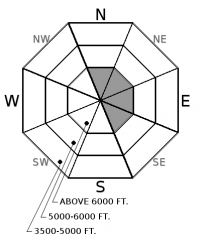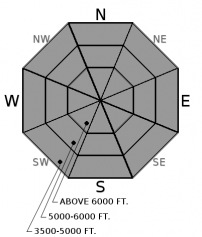| Monday | Monday Night | Tuesday | |
|---|---|---|---|
| Cloud Cover: | Partial clearing | Partial clearing | Light snow developing |
| Temperatures: | 22 to 27 deg. F. | 7 to 12 deg. F. | 20 to 25 deg. F. |
| Wind Direction: | W | SW | SW |
| Wind Speed: | 1 to 11mph | 5 to 10 mph, gusts to 20 | 5 to 15 mph, gusts to 25 |
| Snowfall: | 0 to 1 in. | 0 to 1 in. | 1 to 2 in. |
| Snow Line: |
Whitefish Range
Swan Range
Flathead Range and Glacier National Park
How to read the forecast
The recent storm has ended down but the avalanche hazard remains elevated. Fresh wind slabs continue to thicken on leeward and cross-loaded slopes at upper elevations. Yesterday's relatively dense snow is forming a storm slab problem in sheltered terrain. Watch for signs of instabilities in the new snow and wind-deposited snow such as cracking or collapsing.

3. Considerable
?
Above 6500 ft.
2. Moderate
?
5000-6500 ft.
2. Moderate
?
3500-5000 ft.
- 1. Low
- 2. Moderate
- 3. Considerable
- 4. High
- 5. Extreme
-
Type ?
-
Aspect/Elevation ?

-
Likelihood ?CertainVery LikelyLikelyPossible
 Unlikely
Unlikely -
Size ?HistoricVery LargeLargeSmall

Gusty southwest winds have redistributed up to 13" of new snow into thicker slabs on leeward and cross-loaded slopes. Observers yesterday reported sensitive wind slabs up to 2 feet thick. Look for lens-shaped features behind trees and rock outcroppings. Pillows of snow below ridgelines and in gullies identify wind loaded terrain. Cracking and collapsing in the snow is an obvious sign of instability. Evaluate all wind loaded terrain before committing to a slope.
-
Type ?
-
Aspect/Elevation ?

-
Likelihood ?CertainVery LikelyLikelyPossible
 Unlikely
Unlikely -
Size ?HistoricVery LargeLargeSmall

Yesterday's relatively warm dense snow is resting on colder low-density snow creating an upside down snow surface. Storm slab instabilities will linger longer in areas of greater deposition. Watch for instabilities in the new snow, breaking as soft slabs or sluffs, in wind protected terrain at all elevations. Use hand pits or test slopes to see how the new snow is bonding with the underlying layer. Cracking under your feet or machine is an obvious sign of a tender slab. Use caution above gullies and terrain traps.
-
Type ?
-
Aspect/Elevation ?

-
Likelihood ?CertainVery LikelyLikelyPossible
 Unlikely
Unlikely -
Size ?HistoricVery LargeLargeSmall

Deep slabs remain a low likelihood, high consequence problem. We have limited observations of deep slabs failing naturally during the last storm cycle and confined to the Flathead Range. These large and deadly avalanches are becoming more stubborn to human triggers as snow depths increase. Deep slabs are most likely triggered from shallow, rocky terrain or cornice falls in alpine terrain. Choose slopes well anchored by trees or supported by concave terrain features along with deep, uniform snow cover at higher elevations. This blog post provides more insight into the problem.
Yesterday's storm favored the Whitefish Range, interior Glacier Park, and John F. Stevens Canyon. Noisy Basin reported minimal precipitation and the jury is still out on the Flathead Range. Up to 13" of great riding snow fell slightly warmer and denser than Friday's cold smoke. This upside down snow structure resulted in a storm slab problem. Yesterday I worked the SAR east of WMR ski area, in the Whitefish Range, and noted cracking, shooting cracks and was able to intentionally trigger storm slab avalanches on steep terrain. Zach was in the Flathead Range where he noted similar results despite the less new snow. Storm slabs are a short-lived avalanche problem with thicker storm slabs taking longer to heal than thinner slabs. The more concerning avalanche problem today is wind slabs on upper elevation leeward terrain. Due to wind transport, these slabs will be thicker and instabilities will last longer. Zach was able to intentionally trigger these yesterday above Marion Lake (observation). With plenty of new snow available for transport continued wind will thicken these slabs throughout the day.
Today we can expect dry conditions with seasonal temperatures and light to moderate southwest winds. Limited moisture returns to our area tomorrow with mostly cloudy skies and perhaps a few inches of snow. Unsettled weather continues through the week.
This advisory applies only to backcountry areas outside established ski area boundaries. This advisory describes general avalanche conditions and local variations always occur. This advisory expires at midnight on the posted day unless otherwise noted. The information in this advisory is provided by the USDA Forest Service who is solely responsible for its content.






































